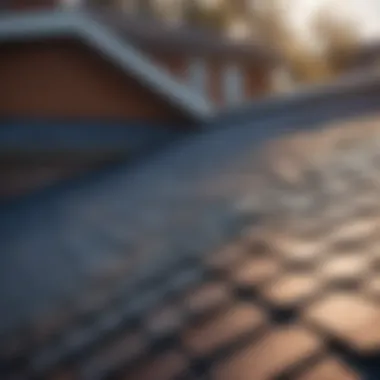Materials:
- Roofing Materials:
- Dimensional shingles: 25 bundles (each bundle covers 33.3 sq. ft)
- Underlayment: 2 rolls of waterproofing membrane (3 feet in width)
- Starter shingles: 3 bundles
- Tools:
- Tape Measure
- Basics Tool Kit: hammer, utility knife, pry bar
- Roofing Nailer
- Ladder
DIY Steps:
- Assess Damage: Begin by inspecting the damaged area on your roof. Look for signs of wear, leaks, or missing shingles.
- Select Materials: Choose high-quality dimensional shingles that match your existing roof, along with the necessary underlayment and starter shingles.
- Prepare the Area: Clear the damaged section, removing debris, and ensuring a clean, smooth surface for installation.
- Cutting and Fitting: Measure and cut the dimensional shingles to fit the damaged area accurately, ensuring a proper overlap for waterproofing.
Technical Aspects:
- Timing Specifics:
- Plan to undertake the replacement on a dry day with moderate temperature for optimal sealing of shingles.
- Critical Techniques:
- Proper nailing techniques: Nail shingles securely without overdriving to prevent damage.
DIY Project Process:


- Installation Method: Start from the bottom up, overlapping each row of shingles to prevent water infiltration. Secure with roofing nails in the designated areas.
- Key Techniques: Use chalk lines for straight alignment and follow manufacturer instructions for proper overlapping and nailing techniques.
- Troubleshooting Tips: In case of misalignment, gently lift shingles and reposition them without causing damage.
Introduction


In the realm of home maintenance and improvement, the roof stands as a crucial element often overlooked until issues arise. The Introduction section of this comprehensive guide focuses on highlighting the pivotal role that understanding and addressing roof damage plays in the longevity and functionality of a home's structure. By delving into the intricacies of roof damage assessment and replacement, homeowners can gain valuable insights into maintaining the integrity of their roofs.
Addressing roof damage promptly is essential to prevent further deterioration, which can lead to more significant structural issues and costly repairs down the line. Through thorough inspection and proper replacement techniques, homeowners can extend the lifespan of their roofs and ensure the safety and comfort of their living space. This crucial initial step lays the foundation for a successful roof replacement project, setting the tone for the subsequent sections of this guide where we will explore in detail the process of replacing a section of a roof, from start to finish.
Understanding roof damage is not just about fixing visible issues but also about ensuring the overall health of the roof system. By grasping the nuances of identifying problem areas and determining the extent of replacement needed, homeowners can make informed decisions that align with the specific requirements of their roofs. This introductory phase sets the stage for a thorough examination of the current state of the roof, guiding homeowners towards effective solutions and preparations for a seamless replacement process.
Understanding Roof Damage


In the realm of roof maintenance, understanding roof damage holds paramount significance. It serves as the foundational component in the entire process of replacing a section of the roof. Identifying the intricacies of roof damage enables homeowners to address issues promptly and efficiently, ultimately enhancing the longevity and structural integrity of their homes.
Identifying the Problem Areas
When delving into the task of identifying problem areas on a roof, several key considerations come into play, primarily centered around Checking for Leaks, Inspecting for Shingle Damage, and Assessing Structural Issues.
Checking for Leaks
The process of checking for leaks involves a meticulous assessment of any signs of water infiltration through the roof. This crucial step helps pinpoint areas of vulnerability that may lead to further damage if not addressed promptly. By identifying and fixing leaks, homeowners can mitigate the risk of extensive structural issues and preserve the overall condition of their property.
Inspecting for Shingle Damage
Inspecting for shingle damage entails a thorough examination of the roof's shingles to uncover any signs of wear and tear, cracks, or missing pieces. Understanding the condition of the shingles is vital in determining the extent of replacement needed and ensuring the proper functionality and protection of the roof. By identifying and replacing damaged shingles, homeowners can safeguard their roofs against potential leaks and further deterioration.
Assessing Structural Issues
The process of assessing structural issues involves evaluating the underlying framework and support system of the roof. By identifying any structural weaknesses or damage, homeowners can make informed decisions regarding the necessary repairs or replacements. Addressing structural issues proactively ensures the overall stability and strength of the roof, guarding against potential safety hazards and costly structural damage.
Determining the Extent of Replacement
Once the problem areas have been identified, the next crucial step is determining the extent of replacement required to restore the roof's functionality and durability.
Measuring the Damaged Area
Measuring the damaged area provides homeowners with accurate dimensions essential for planning the replacement process effectively. By carefully measuring the extent of the damage, homeowners can ensure that the replacement materials align seamlessly with the existing structure, promoting a cohesive and resilient roof system.
Consulting with Roofing Professionals
Collaborating with roofing professionals offers invaluable expertise and insights into the optimal approaches for replacing the damaged roof section. By seeking guidance from experienced professionals, homeowners can benefit from tailored recommendations, cost-effective solutions, and precise execution, ultimately yielding a superior and long-lasting outcome.
Preparing for Replacement
Before embarking on the replacement process, thorough preparation is essential to streamline the project and ensure a successful outcome.
Gathering Necessary Tools and Materials
Gathering the necessary tools and materials in advance is crucial for a smooth and efficient replacement process. By ensuring that all essential supplies are readily available, homeowners can minimize disruptions, maximize productivity, and facilitate a seamless transition from old to new, facilitating a timely and effective replacement process.
Ensuring Safety Measures
Prioritizing safety measures is paramount to safeguarding oneself and others during the replacement project. By adhering to stringent safety protocols, including wearing appropriate protective gear and securing ladders properly, homeowners can mitigate the risk of accidents and ensure a secure working environment, fostering a safe and productive undertaking.
Selecting Roofing Materials
Selecting the right roofing materials is a critical aspect of the roof replacement process. The quality of materials chosen directly impacts the longevity and durability of the new roof section. When considering roofing materials, several key elements should be taken into account to ensure the best results.
Choosing the Right Shingles
When it comes to shingles, there are various types available in the market, each with its unique characteristics and benefits. Asphalt shingles, for instance, are widely popular due to their affordability, ease of installation, and decent durability. They come in different styles, such as three-tab, architectural, and designer shingles, offering versatility and aesthetic appeal.
Quality and Durability Considerations
Quality and durability considerations are crucial factors when selecting roofing materials. Opting for high-quality shingles that can withstand harsh weather conditions and provide long-term protection is vital for a successful roof replacement project. Durable shingles can resist impact, strong winds, and UV rays, ensuring the roof's resilience over time.
Color and Style Options
The color and style of shingles contribute significantly to the overall look of a home. Homeowners should choose shingles that complement the architectural style and color scheme of their property. Whether opting for traditional shades like grey and brown or more vibrant hues, such as red or blue, selecting the right color can enhance curb appeal and boost the property's value.
Exploring Underlayment Options
Underlayment plays a crucial role in waterproofing and protecting the roof deck from moisture. Two common types of underlayment are felt and synthetic materials, each offering distinct advantages.
Felt Underlayment
Felt underlayment, also known as tar paper, is a traditional choice for roof underlayment. It provides a protective barrier against water infiltration and helps in maintaining the roof's integrity. Felt underlayment is cost-effective and easy to install, making it a popular option for various roofing projects.
Synthetic Underlayment
Synthetic underlayment is a modern alternative to felt underlayment, offering superior waterproofing properties and enhanced durability. Made from polypropylene or polyethylene, synthetic underlayment resists wrinkling, tearing, and UV exposure better than traditional felt. Although slightly pricier, synthetic underlayment provides better protection and longevity, making it a valuable investment for homeowners seeking long-term roof performance.
Removing the Damaged Roof Section
When it comes to the process of replacing a section of a roof, the step of removing the damaged roof section is crucial. This section sets the foundation for the new installation and ensures that the project proceeds smoothly. By focusing on this aspect with precision and care, you lay the groundwork for a successful roof replacement.
Safety Precautions
In any roofing project, prioritizing safety precautions is of utmost importance to prevent accidents and ensure a secure working environment. Let's delve into two key safety measures:
Wearing Protective Gear
Within the realm of roofing, wearing protective gear is non-negotiable. High-quality, durable gear offers essential protection against potential hazards, such as falling debris and harsh weather conditions. By donning protective gear, roofers safeguard themselves and enhance efficiency, making it a staple in any roofing venture.
Securing Ladders
Securing ladders is a fundamental safety practice that cannot be understated. Sturdy, properly positioned ladders reduce the risk of falls and provide stable support during the roofing process. Their portability and ease of use make them a practical choice, essential for access to elevated areas securely.
Demolition Process
Moving on to the demolition process, this stage involves meticulous actions to clear the damaged area effectively and prepare for the new installation. Let's explore two vital aspects within this stage:
Tearing off Shingles
Tearing off shingles demands precision and expertise to remove the existing roof elements without causing damage to the underlying structure. With a focus on careful dismantling, this step ensures a clean slate for the new roof section. The methodical approach to shingle removal streamlines the process and sets the stage for a seamless transition.
Inspecting Decking
Inspecting decking is a critical task to assess the condition of the roof's foundation before proceeding with the replacement. By scrutinizing the decking for any signs of damage or wear, roofers can address potential issues promptly. Identifying underlying problems at this stage prevents future complications and guarantees a sturdy base for the new roof section.
Installing the New Roof Section
When it comes to replacing a part of your roof, the installation of the new section is a crucial step in ensuring the durability and longevity of your roofing system. This section focuses on laying the foundation for the new roof and securing it properly to protect your home from external elements.
Laying the Foundation
Replacing Decking if Needed
Replacing decking, if necessary, is essential to provide a solid base for the new roof section. Whether due to water damage, rot, or wear and tear, replacing damaged decking ensures a sturdy foundation for the roof. Choosing durable and suitable decking materials is key to the success of this step. Opting for high-quality decking materials forms the basis for a long-lasting roof that can withstand various weather conditions.
Applying Underlayment
Applying underlayment is another critical aspect of installing the new roof section. Underlayment acts as a protective barrier between the decking and the shingles, enhancing waterproofing and improving the overall roof system's performance. Selecting the appropriate underlayment, such as felt or synthetic options, depends on factors like climate, budget, and personal preference. Proper application and sealing of underlayment contribute significantly to the roof's durability and longevity.
Shingle Installation
Proper Shingle Alignment
Proper shingle alignment is crucial for a visually appealing and structurally sound roof. Aligning shingles correctly not only enhances the roof's aesthetic appeal but also ensures that each shingle overlaps properly, forming a tight seal against moisture. This meticulous process prevents water infiltration and promotes efficient water shedding, reducing the risk of leaks and water damage. Proper shingle alignment showcases attention to detail and craftsmanship, making your roof stand out in both function and form.
Securing Shingles
Securing shingles effectively reinforces the roof's protective barrier against external elements. Properly secured shingles with nails or adhesive prevent uplift due to wind, maintaining the roof's integrity and stability. Choosing the right fastening method and ensuring secure attachment at appropriate intervals are crucial aspects of shingle installation. Securely fastened shingles enhance the roof's resistance to wind uplift, improving its overall performance and longevity.
Finishing Touches
Installing Ridge Vents
Installing ridge vents is essential for proper attic ventilation and heat regulation. Ridge vents facilitate the flow of air in the attic, preventing moisture buildup and excessive heat, which can compromise the roof's structure and insulation. Proper installation of ridge vents ensures optimal ventilation, reducing energy costs and enhancing the longevity of the roof system. Choosing quality ridge vents and correct placement are key factors in maintaining a well-ventilated attic and a healthy roofing environment.
Cleaning Up the Work Area
Cleaning up the work area post-installation is a final step that showcases attention to detail and professionalism. Removing debris, leftover materials, and ensuring a clean and organized work environment not only enhances the visual appeal of your home but also promotes safety and efficiency. Proper cleanup prevents potential safety hazards and ensures a seamless transition to enjoying your newly replaced roof section. Thorough cleaning contributes to a polished finish and demonstrates a commitment to quality workmanship.
Conclusion
In this comprehensive guide on replacing a section of a roof, the conclusion serves as a crucial component tying together all the intricate steps involved in this project. The completion of the installation marks the culmination of meticulous planning, skillful execution, and unwavering commitment to enhancing the structural integrity and aesthetics of your home. As homeowners, reaching the final stage of a roof replacement project brings about a sense of accomplishment and satisfaction in knowing that your investment has resulted in a durable and visually appealing roof surface.
The conclusion is not merely the endpoint of the physical work but also a moment of reflection on the journey undertaken from assessing initial roof damage to meticulously selecting materials and navigating through the installation process. It underscores the significance of attention to detail throughout each stage to ensure a seamless and long-lasting roof section replacement.
Furthermore, the conclusion encapsulates the essence of the entire guide, emphasizing the importance of following best practices in roofing maintenance to prolong the lifespan of your roof and safeguard your home against weather elements. By adhering to the recommendations provided in this guide, homeowners can rest assured that their roof replacement project is executed with precision and quality craftsmanship, ultimately adding value to their property and enhancing its curb appeal.
In summary, the conclusion of this article not only signifies the successful completion of a roof section replacement but also underscores the commitment to excellence and diligence required in every aspect of home maintenance. It is a testament to the homeowner's dedication to ensuring a safe, secure, and visually appealing roof for years to come.





